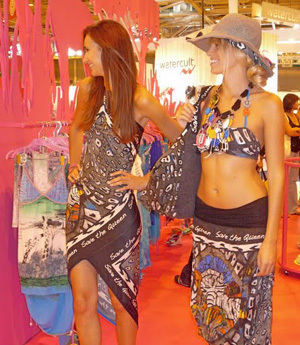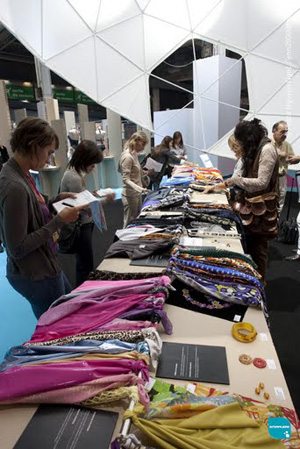
Framework Knitters Museum wins TripAdvisor award
Debra Cobb reports from Paris Archival laces and embroideries as well as new fabric and fibre technologies generated excitement at last week’s Interfilière in Paris. While the show was noticeably smaller with fewer exhibitors and attendees, traffic was steady at those knitters known for quality and innovation. The Eurovet organization has not released attendance figures, but suppliers said they were pleasantly surprised by the attendance and were cautiously optimistic with business looking u

13th September 2009
Knitting Industry
|
Paris
Debra Cobb reports from Paris
 Archival laces and embroideries as well as new fabric and fibre technologies generated excitement at last week’s Interfilière in Paris. While the show was noticeably smaller with fewer exhibitors and attendees, traffic was steady at those knitters known for quality and innovation. The Eurovet organization has not released attendance figures, but suppliers said they were pleasantly surprised by the attendance and were cautiously optimistic with business looking up for the third quarter.
Archival laces and embroideries as well as new fabric and fibre technologies generated excitement at last week’s Interfilière in Paris. While the show was noticeably smaller with fewer exhibitors and attendees, traffic was steady at those knitters known for quality and innovation. The Eurovet organization has not released attendance figures, but suppliers said they were pleasantly surprised by the attendance and were cautiously optimistic with business looking up for the third quarter.
The General Forum for intimates was dominated by lace and embroidery, as Interfilière celebrated the International Lace and Fashion Centre recently opened in Calais. An inspiring archival display featured intimate apparel prototypes developed in collaborations between designers and the archives from Noyon Dentelle, Piave Maitex, Oskar Hammerle and Bischoff Textiles.
Swimwear trends were highly decorative and inspired by couture techniques. Sheers and skin-thin fabrics for draping contrasted with knitted satins, sculptural jacquards, terries, velours and dévorés. The knitters have mastered new developments in fine-gauge knitting, as well as in treatments such as inkjet and digital printing, glossy foil prints, flocking and burn-outs. The interpretation of archival and couture references into today’s highly technical knitted fabrics resulted in fabrics that are not only beautiful but perform to the standards required by today’s lingerie and swimwear manufacturers.
Fine-gauge knits are the future, according to Dr. Martin Hermann, Managing Director at Willy Hermann. The company pioneered fine-gauge knitting in 2000 with 44 gg—now the volume category—and can knit as fine as 68 gg. These Superfine fabrics are ideal for clean-cut and sew-free technologies.
Second-skin fabrics knit at 44 gg are standard at Maglificio Ripa, where they make up 50 -60% of production. These include fabrics with Xtra Life LYCRA® for beachwear as well as delicious blends of natural and cellulosic fibres—MicroModal®, cashmere, silk, bamboo and milk fibre—for intimates and loungewear.
 Brugnoli’s “Invisible” line of nylon blends with high elasthane content go as light as 55 gsm, with heavier versions in development using Xtra Life LYCRA® for swimwear. Brugnoli also featured a range of organic cottons and blends of natural and cellulosic fibres including MicroModal®, wool and cashmere for cozy loungewear.
Brugnoli’s “Invisible” line of nylon blends with high elasthane content go as light as 55 gsm, with heavier versions in development using Xtra Life LYCRA® for swimwear. Brugnoli also featured a range of organic cottons and blends of natural and cellulosic fibres including MicroModal®, wool and cashmere for cozy loungewear.
Huber Tricot’s line of fine-gauge “Smooth Skin” jerseys included 50gg fabrics as well as a 65 gsm mercerized cotton jersey knit at 44 gg. Their new “Brightex” treatment utilises long-staple yarns and special finishing to impart soft lustre and pilling resistance. The company is a member of the Organic Exchange and has developed knits in organic and natural-colour cotton. Other offerings included fine-gauge blends of bamboo, wool or cotton with silk or even cashmere.
Eurojersey has also been at the forefront of light weight stretch knits with their warp-knit Sensitive® range, and this season offered a semi-sheer version called Sensitive® Touch that is perfect for intimate apparel. The new weight was teamed with more compact Sensitive® fabrics in “shape and drape” swimwear by designer Karla Colletto, featured in the Beach Innovation Forum.
Tulles, meshes and power nets were also in demand for intimates. Penn Asia introduced sheer, meshy stretch laces knit on Karl Mayer’s new “Cliptronic” machine, as well as cotton-blend meshes with and without stretch. Andre Avio’s silk tulles were exquisite, as was their organic cotton net at 40 gsm and knitted cotton charmeuse at 118 gsm.
Thinner and lighter than ever, spacer fabrics such as Dogi’s “Perfect Bra” weft-knit range have become increasingly important for intimate apparel as they offer a non-yellowing option to PU foam for bra cups. Without the need for a fabric covering, spacers also offered a number of fashion options, including jacquard, mesh, sheer/opaque and reversible constructions as seen at Liebaert and Mackent.
Fabrics for shapewear were focused on comfort and a smooth appearance, with seamless knitting and zoned power stretch important for this classification. Penn Elastic’s “Dreamshape” offered “weightless power” through engineered shaping and supermicro yarns; the company is partnering with a Moroccan manufacturer to offer full package options to their customers. At Dogi, new fabrics in their “Winn” wellness collection promised firming or slimming benefits through specialty yarns from Nurel. Noyon Dentelle’s “Glam’Panties” laces were engineered to create body-shaping briefs with a single seam.
 Enhanced performance
Enhanced performanceSwimwear performance was enhanced by new fibres and finishings. Carvico’s “Revolutional” range of light, compact warp knits was offered with Schoeller’s “Cold Black” technology, preventing absorption of heat from the sun. Carvico’s new “Amazzonia” range combined eco-friendly Biophyl™ (made from DuPont Sorona®) and Dow XLA™. Weft-knitter Jersey Lomellina presented new developments with Invista’s T-400® stretch fibre. At Talana Virgillo a patented nano-process imparted the water-repellent qualities of the lotus to knits for stay-dry swimwear.
Piave Maitex introduced flocking and burn-out technologies developed especially for swimwear, collaborating with designer Anna Maria LaBianca to create lace-inspired patterns. The company’s new base cloth utilises a polyester yarn with a polyamide core and nano-TiO2, knit with Xtra Life LYCRA®. The fabric provides UV protection and excellent coverage, with no lining required.
Velvets, towelings, laces and dévorés were featured for luxurious loungewear and “evening” beachwear. These included MicroModal® toweling at Handel & Diller, burn-out cotton lace effect at Natex, and a range of velours at Piave Maitex.
The fibre companies showing at the fair continued their efforts toward sustainability, including NILIT’s introduction of their Eco-Care post-industrial recycled nylon, which incorporates 10% recycled Colorwise deep-dye nylon for improved dyeability. Hyosung’s Mipan Regen nylon was featured in the launch of Eco-Panda’s swimwear line in China, and their eco-friendly Creora H550 has found favour in knits blended with natural fibres or polypropylene that require a lower temperature for heat-setting.
Lenzing featured their ProModal® blend of Modal/Tencel, which has found commercial success at Abercrombie & Fitch in loungewear. Their MicroModal® AIR in very fine counts was shown in knits by Handel & Diller. Lenzing’s newest concept for knits is an eco-blend of Tencel® LF with organic cotton.
Invista’s prototype intimate apparel garments using LYCRA® 2.0 garment technology in partnership with Willy Hermann’s Superfine fabrics were a vision of the future of intimate apparel and other bodywear. Cacique has launched the first commercial LYCRA® 2.0 garment, the Back-Smoother bra; and fashion legwear is in the works, using clean-cut Sensitive® fabrics from Eurojersey.
Asahi from Japan has brought to market an adhesive elasthane, ROICA SF for clean-cut fabric, said to prevent curling and laddering on both warp and weft knits. Asahi also offered a deep dyeable elasthane, compatible with nylon or polyester, as well as a new bonding tape from internally produced polymer providing a soft hand-feel and excellent stretch and recovery.

Business intelligence for the fibre, textiles and apparel industries: technologies, innovations, markets, investments, trade policy, sourcing, strategy...
Find out more